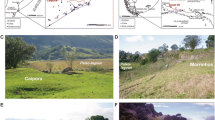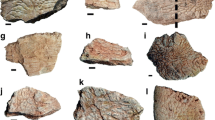Abstract
Abrasion is a taphonomic process of three-dimensional alteration and destruction of bivalve (and other shelly biota) shell morphology. In this study, abrasion processes inGlycymeris glycymeris and their relationships are presented, quantified and compared with fossil analogues. The Recent material was sampled from sandy beaches of NW France (Normandy). As a basis for describing abrasion patterns and paths, a revised description of the non-abraded morphology ofG. glycymeris is provided. For an analysis of shell microstructure abrasion patterns, fracture samples as well as polished and etched thin-sections were studied by SEM and TLM methods. Based on 524 specimens ofG. glycymeris, abrasion patterns of nine shell characters (valve outline; external shell surface ornamentation;external colour pattern and periostracum; beak/umbo depression; beak/umbo facets;hinge plate;ligamental area; internal shell surface within palliai line and adductor scars; crenulation of the inner ventral margin) were divided into 6–10 abrasion stages, arranged in their successive order. By means of cluster and correspondence analyses, the subjective order of abrasion stages was tested. Particular abrasion stages of certain characters are quite frequent, whereas others are rare. Consequently, some stages are either biased or our subjective stages are positioned within a consecutive path and not well defined. Cluster analysis revealed that certain characters are quite closely correlated; others do not show any relationships. The results derived from the Recent material are compared with two fossil examples,Glycymeris obovata and G. pilosa deshayesi, from the Tertiary of Central Europe.
Kurzfassung
Abrasion, ein taphonomischer Prozess flächenhafter, dreidimensionaler Veränderung und Zerstörung der Morphologie von Gehäusen aquatischer Organismen, wird am Beispiel vonGlycymeris glycymeris quantifiziert, Abhängigkeiten des Prozesses werden aufgezeigt und auf fossile Beispiele übertragen. Das rezente Material stammt aus dem sandigen Intertidal der Normandie (Frankreich). Als Ausgangsbasis für die Analyse von Abrasionsphänomenen wurde eine Neubeschreibung der Morphologie erstellt; anschließend die Darstellung der Abrasionserscheinungen. Um Abrasionsphänomene im Detail zu erkennen, wurden Bruchpräparate und Dünnschliffe (geätzt / poliert) hergestellt, die lichtmikroskopisch und im REM untersucht wurden und den Vergleich von abradierten und nicht-ab-radierten Schalen ermöglichten. Um die subjektiv beobachtbaren Abrasionsmuster und -Stadien in einen zeitlichen Zusammenhang zu bringen und einen Abrasionsverlauf rekonstruieren zu können, wurde exemplarisch fürG. glycymeris aus 524 untersuchten Einzelklappen ein Katalog von Merkmalen und Abrasionsstufen erstellt. Die neun Merkmale / Merkmalskomplexe (Klappenumriss; Skulptur; Farbe u. Periostrakum; Wirbelvertiefungen; Wirbelfacetten; Schlossplatte; Ligament u. Area; Innenschicht; Ventralrand) wurden in jeweils 6-10 Abrasionsstufen untergliedert und in ihren zeitlichen Verlauf geordnet. Mit Hilfe von Cluster- und Korrespondenzanalyse erfolgte die Objektivierung der subjektiv festgelegten Abrasionsschritte. Bestimmte Abrasionsstufen bestimmter Merkmale treten besonders häufig und andere äußerst selten auf, so dass die Abrasionsstufen nicht gleichmäßig verteilt sind. Aus der Clusteranalyse lässt sich ableiten, dass bestimmte Merkmale (Umriss, Schlossplatte und Ligament bzw. Skulptur und Farbe) eng miteinander korrelieren, während andere kaum miteinander in Beziehung stehen. Die am Rezentmaterial gewonnenen Ergebnisse werden exemplarisch mit zwei fossilen Vertretern,Glycymeris obovata undG. pilosa deshayesi, aus dem Tertiär Mitteleuropas verglichen.
Similar content being viewed by others
References
Agenda Systematik 2000 1996. Erschließung der Biosphäre. — Kleine Senckenberg-Reihe22: 1–55.
Amler, M.R.W.;Fischer, R. &Rogalla, N.S. 2000. Muscheln. —Erben, H.K.;Hillmer, G. &Ristedt, H., ed., Haeckel-Bücherei 5. — 214 p., Stuttgart (Enke im Thieme).
Bøggild, O.B. 1930. The shell structure of the molluscs. — Danske Videnskrift Selsk. Skifter, Naturvidenske. og mathem. Afd. 9, Raekke2(2):231–326.
Brett, A.H. &Baird, G.C. 1962. Comparative taphonomy: a key to paleoenvironmental interpretation based on fossil preservation. — Palaios1: 207–227.
Cadée, G.C. 1968. Molluscan biocoenoses and thanatocoenoses in the Ria de Arosa, Galicia, Spain. — Zoologische Verhandelingen van het Rijksmuseum van Natuurlijke Historie Leiden95: 1–121, 52 Abb., 6 Taf.; Leiden.
Cadée, G.C. &Wesselingh, F. 2005. Van levend schelpdier naar fossiele schelp: tafonomie van nederlandse strandschelpen. — Spinila343: 36–52.
Carter, J.G., ed. 1990. Skeletal Biomineralization: Patterns, Processes and Evolutionary Trends. — vii + 800 p., New York (Van Nostrana Reinhold).
Cutler, A.H. 1995. Taphonomic implications of shell surface textures in Bahia la Choya, northern Gulf of California. — Palaeogeogra-phy, Palaeoclimatology, Palaeoecology114: 219–240.
Deichsel, G. &Tampisch, HJ. 1985. Clusteranalyse und Diskriminanzanalyse. — 135 p., Stuttgart (G. Fischer).
Driscoll, E.G. 1967. Experimental field study of shell abrasion. — Journal of Sedimentary Petrology37 (4): 1117–1123.
Driscoll, E.G. 1970. Selective bivalve shell destruction in marine environments, a field study. — Journal of Sedimentary Petrology40: 898–905.
Driscoll, E.G. &Weltin, T.P. 1973. Sedimentary parameters as factors in abrasive shell reduction. — Palaeogeography, Palaeoclimatology, Palaeoecology13: 275–288.
Etter, W. 1994. Palökologie. — 294 p., Basel (Birkhäuser).
Feige, A. &Fürsich, FT. 1991. Taphonomy of Recent molluscs of Bahia la Choya (Gulf of California, Sonora, Mexico). — In:Fürsich, F.T. &Flessa, K.W., eds., Ecology, Taphonomy, and Palaeoecology of Recent to Pleistocene molluscan faunas of Bahia la Choya, Northern Gulf of California. — Zitteliana18: 89–133.
Franc, A. 1960. Classe de Bivalves. — In:Grasse, P.-P., ed., Traite de Zoologie,5 (2): 1845–2133, Paris (Masons et Cie).
Fürsich, F. T. &Flessa, K. W., eds. 1991. Ecology, Taphonomy, and Palaeoecology of Recent to Pleistocene molluscan faunas of Bahia la Choya, Northern Gulf of California. — Zitteliana18: 1–180.
Futterer, E. 1974. Untersuchungen zum Einsteuerungsverhalten der Einzelklappen vonCardium echinatum L. undCardium edule L. im Strömungskanal. — Neues Jahrbuch für Geologie und Paläontologie, Monatshefte8: 449–455.
Futterer, E. 1976. Rezente Schule: Transport und Einregelung tierischer Hartteile im Strömungskanal. — Zentralblatt für Geologie und Paläontologie5/6: 267–271.
Futterer, E. 1978. Studien über Einregelung, Ablagerung und Einbettung biogener Hartteile im Strömungskanal. — Neues Jahrbuch für Geologie und Paläontologie, Abhandlungen156: 87–131.
Gabriel, J.M. 1981. Differing resistance of various mollusc shell materials to simulated whelk attack. — Journal of Zoology194: 363–369.
Glibert, M. 1945. Faune malacologique du Miocène de la Belgique. — Mémoires du Musée Royal d’Histoire Naturelle de Belgique103: 1–266.
Goldfuss, A. 1833–1841. Petrefacta Germaniae, Abbildungen und Beschreibungen der Petrefacten Deutschlands und der angrenzenden Länder,2. — 312 p., pis. 72–165, Düsseldorf (Arnz & Co.) [1–68, pis. 72–96 (1833); 69–140, pis. 97–121 (1835); 141–224, pis. 122–146 (1837); i–iii, 225–312, pis. 147–165 (1841)].
Hayward, PJ. &Ryland, J.S., eds. 1996. Marine Fauna of North-West Europe. — 800 p., Oxford (Oxford University Press).
Hollmann, R. 1968a. Zur Morphologie rezenter Mollusken-Bruchschille. — Paläontologische Zeitschrift42 (3/4): 217–235.
Hollmann, R. 1968b. Über Schalenabschliffe beiCardium edule aus der Königsbucht bei List auf Sylt. — Helgoländer Wissenschaftliche Meeresuntersuchungen18 (1/2): 169–193.
Janssen, R. 1979. Revision der Bivalvia des Oberoligozäns (Chattium, Kasseler Meeressand). — Geologische Abhandlungen Hessen78: 1–181.
Kennish, M.j.;Lutz, R.A. &Rhoads, D.G. 1980. Preparation of acetate peels and fractured sections for observation of growth patterns within the bivalve shell. — In:Rhoads, D.C. &Lutz, R.A., eds., Skeletal growth of aquatic organisms. — Topics in Geobiology1: 597–601, New York, Pa. (Plenum Press).
Kessel, E. 1938. Über Erhaltungsfâhigkeit mariner Molluskenschalen in Abhängigkeit von der Struktur. — Archiv für Molluskenkunde70: 248–254.
Klähn, H. 1932. Der quantitative Verlauf der Aufarbeitung von Sanden, Geröllen und Schalen in wässerigem Medium. — Neues Jahrbuch für Mineralogie, Geologie und Paläontologie, Beilagen-Band (B)67: 313–412.
Kuenen, P.H. 1956a. Experimental Abrasion of Pebbles: 1. Wet Sand Blasting. — Leidse Geologische Mededelingen [for 1955]20: 142–150.
Kuenen, P.H. 1956b. Experimental Abrasion of Pebbles: 2. Rolling by current. — Journal of Geology64: 336–368.
Kuenen, P.H. 1959. Experimental Abrasion: 3. Fluviatile Action on Sand. — American Journal of Science257: 172–190.
Lawrence, D.R. 1968. Taphonomy and information losses in fossil communities. — Geological Society of America, Bulletin79: 1315–1330.
Lever, J. 1958. Quantitative beach research: I. The “left-right-phenomenon“: sorting of Lamellibranch valves on sandy beaches. — Basteria22: 21–68.
Lever, J.;Kessler, A.;van Oveerbeeke, A.P. &Thijssen, R. 1961. Quantitative beach research: II. The “hole-effect”. — Netherlands Journal of Sea Research1: 339–358.
Linnaeus, C. 1758. Systema naturae, regnum animale1, editio 10. — 824 p.; Holmiae [Stockholm] (Laurentii Salvii).
Mitchell-Tapping, H.J. 1980. Abrasion rates of certain marine shells and corals. — Florida Scientist43 (4): 279–284.
Moerduk, P.W. &van Nieulande, F.A.D. 2000. Revision of Pliocene Glycymerididae (Mollusca, Bivalvia) from the North Sea Basin. — Contributions to Tertiary and Quaternary Geology37 (1/2): 3–21.
Papp, A. 1941. Beobachtungen über Aufarbeitung von Molluskenschalen in Gegenwart und Vergangenheit. — Verhandlungen der Zoologisch-Botanischen Gesellschaft zu Wien88/89: 231–236.
Popov, S.V. 1992. Mikrostruktura rakoviny nekotrych grupp dvustvor-catych molljuskov. — Trudy Paleontologiceskogo Instituta, Ross-ijskaja Akademija Nauk245: 1–46.
Pratje, O. 1929. Fazettieren von Molluskenschalen. — Paläontologische Zeitschrift11: 151–169.
Rogalla, N.S. 1998a. Die Folgen der Abrasion an Muschelschalen — Fakten, Möglichkeiten oder Fantasien? — Terra Nostra98/3: V285; Köln [abstract of talk].
Rogalla, N.S. 1998b. Taphonomische Untersuchungen zur Abrasion an rezenten und fossilen Muschelschalen. — Diploma thesis, Fachbereich Biologie, Philipps-Universität Marburg. — 188 p., Marburg (unpublished).
Rogalla, N.S. &Amler, M.R.W. 2003. Abrasion an rezenten Bival-venschalen. — Geologica et Palaeontologica37: 107–148.
Sowerby, J. de C. 1823–1825. The mineral conchology of Great Britain; or coloured figures and descriptions of those remains of testaceous animals or shells, which have been preserved at various times and depths in the earth,5. — 168 p., pis. 408–503, London (Arding/R. Taylor).
Taylor, J.D. &Layman, M. 1972. The mechanical properties of bivalve (Mollusca) shell structures. — Palaeontology15: 73–87.
Taylor, J.D.;Kennedy, W.J. &Hall, A. 1973. The shell structure and mineralogy of the Bivalvia, II. Lucinacea — Clavagellacea, Conclusions. — Bulletin of the British Museum (Natural History), Zoology Series22 (9): 253–294.
Tebble, N. 1976. British Bivalve Seashells. — 2. ed., 212 p., Oxford (Alden Press)
Wood, S.V. 1851–1861. A monograph of the Crag Mollusca, with description of shells from the Upper Tertiaries of the British Isles. — Palaeontographical Society Monograph4 (8),7 (24),9 (33): 1–342, pls. 1–31.
Wood, S.V. 1861–1871. A monograph of the Eocene Mollusca, or, descriptions of shells from the older Tertiaries of England, Bivalves. — Palaeontographical Society Monograph13 (58),16 (69),24 (109): 1–182, pis. 1–25.
Author information
Authors and Affiliations
Corresponding author
Rights and permissions
About this article
Cite this article
Rogalla, N.S., Amler, M.R.W. Statistic approach on taphonomic phenomena in shells ofGlycymeris glycymeris (Bivalvia: Glycymerididae) and its significance in the fossil record. Paläontol Z 81, 334–355 (2007). https://doi.org/10.1007/BF02990183
Received:
Accepted:
Issue Date:
DOI: https://doi.org/10.1007/BF02990183




